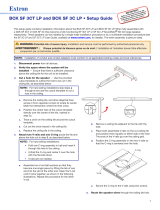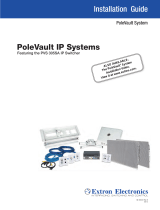
BCK SF 26CT LP • Setup Guide
This setup guide contains installation information about the BCK SF 26CT LP back-can. When installed and assembled together
with the DAK SF 26CT LP, they become a fully fuctional SF 26CT LP Soundeld
®
XD low-prole 2-way speaker.
The complete assembly can be installed by a single-trade installation procedure or by a multi-trade installation procedure (see the
SF 26CT LP User Guide, available at www.extron.com, for details). The entire assembly is plenum-rated.
WARNING: Potential risk of severe injury. Installation and service must be performed by authorized personnel only.
AVERTISSEMENT : Risque potentiel de blessure grave ou de mort. L’installation et l’entretien doivent être effectués
par le personnel autorisé uniquement.
NOTE: Installation of conduit and conduit adapters must conform to all applicable building codes and local ordinances.
Installing the BCK SF 26CT LP in a Suspended Ceiling
Preparing the Installation Location
For hard ceiling installations, see the SF 26CT LP User Guide.
1. Power Down all attached devices.
2. Using the provided cutout template for the outline, cut
a hole for the BCK SF 26CT LP in the ceiling tile, as
described below.
NOTE: For hard ceiling installations, skip steps a
through e, and use the template to cut a hole in
the ceiling.
a. Remove the ceiling tile,
b. Draw diagonal lines across it from opposite corners
to locate its center.
c. Mark the intersection where the lines cross.
d. Position the center hole of the cutout template
directly over the center of the tile, marked in step2a.
e. Trace a circle on the ceiling tile around the cutout
template.
f. Cut out the circle traced in the ceiling tile.
g. Replace the ceiling tile in the ceiling.
3. Attach two V-rails and one C-ring above the hole cut
in step 2, as described below.
NOTE: For hard ceiling installations:
• Fold one C-ring assembly in half and insert it
through the hole in the ceiling.
• Unfold the C-ring and center it over the hole
with the flat side down.
• V-rails are not needed.
a. Assemble two V-rail half-sections so that they
become one single piece by fitting the tab of one
end into the slot of the other end. Open the V-rail
until it locks together (see figure 1). Repeat this
procedure for the other V-rail.
1
Figure 1. Assembling the V-rails
b. Remove a ceiling tile adjacent to the tile with the
hole.
c. Place both assembled V-rails on the cut ceiling tile
and position them equally on either side of the hole.
The ends of the V-rails go over the ceiling grid, as
shown in figure 2.
d. Position the C-ring assembly on the two V-rails so
that the C-ring is centered over the hole.
e. Secure the C-ring to the V-rails using two screws
(see figure 2).
C-ring
-rail
Figure 2. Secure the C-ring to the V-rails





